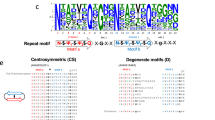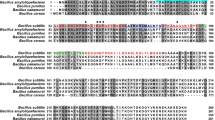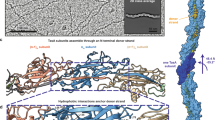Abstract
Curli are functional amyloids produced by proteobacteria like Escherichia coli as part of the extracellular matrix that holds cells together into biofilms. The molecular events that occur during curli nucleation and fiber extension remain largely unknown. Combining observations from curli amyloidogenesis in bulk solutions with real-time in situ nanoscopic imaging at the single-fiber level, we show that curli display polar growth, and we detect two kinetic regimes of fiber elongation. Single fibers exhibit stop-and-go dynamics characterized by bursts of steady-state growth alternated with periods of stagnation. At high subunit concentrations, fibers show constant, unperturbed burst growth. Curli follow a one-step nucleation process in which monomers contemporaneously fold and oligomerize into minimal fiber units that have growth characteristics identical to those of the mature fibrils. Kinetic data and interaction studies of curli fibrillation in the presence of the natural inhibitor CsgC show that the inhibitor binds curli fibers and predominantly acts at the level of fiber elongation.
This is a preview of subscription content, access via your institution
Access options
Access Nature and 54 other Nature Portfolio journals
Get Nature+, our best-value online-access subscription
$29.99 / 30 days
cancel any time
Subscribe to this journal
Receive 12 print issues and online access
$259.00 per year
only $21.58 per issue
Buy this article
- Purchase on Springer Link
- Instant access to full article PDF
Prices may be subject to local taxes which are calculated during checkout






Similar content being viewed by others
References
Chiti, F. & Dobson, C.M. Protein misfolding, functional amyloid, and human disease. Annu. Rev. Biochem. 75, 333–366 (2006).
Knowles, T.P.J., Vendruscolo, M. & Dobson, C.M. The amyloid state and its association with protein misfolding diseases. Nat. Rev. Mol. Cell Biol. 15, 384–396 (2014).
Fowler, D.M., Koulov, A.V., Balch, W.E. & Kelly, J.W. Functional amyloid—from bacteria to humans. Trends Biochem. Sci. 32, 217–224 (2007).
Chapman, M.R. et al. Role of Escherichia coli curli operons in directing amyloid fiber formation. Science 295, 851–855 (2002).
Dueholm, M.S. et al. Functional amyloid in Pseudomonas. Mol. Microbiol. 77, 1009–1020 (2010).
Romero, D., Aguilar, C., Losick, R. & Kolter, R. Amyloid fibers provide structural integrity to Bacillus subtilis biofilms. Proc. Natl. Acad. Sci. USA 107, 2230–2234 (2010).
Schwartz, K., Syed, A.K., Stephenson, R.E., Rickard, A.H. & Boles, B.R. Functional amyloids composed of phenol soluble modulins stabilize Staphylococcus aureus biofilms. PLoS Pathog. 8, e1002744 (2012).
Oli, M.W. et al. Functional amyloid formation by Streptococcus mutans. Microbiology 158, 2903–2916 (2012).
Alteri, C.J. et al. Mycobacterium tuberculosis produces pili during human infection. Proc. Natl. Acad. Sci. USA 104, 5145–5150 (2007).
Toyama, B.H. & Weissman, J.S. Amyloid structure: conformational diversity and consequences. Annu. Rev. Biochem. 80, 557–585 (2011).
Eichner, T. & Radford, S.E. A diversity of assembly mechanisms of a generic amyloid fold. Mol. Cell 43, 8–18 (2011).
Watanabe-Nakayama, T. et al. High-speed atomic force microscopy reveals structural dynamics of amyloid β1-42 aggregates. Proc. Natl. Acad. Sci. USA 113, 5835–5840 (2016).
Bucciantini, M. et al. Inherent toxicity of aggregates implies a common mechanism for protein misfolding diseases. Nature 416, 507–511 (2002).
Kayed, R. et al. Common structure of soluble amyloid oligomers implies common mechanism of pathogenesis. Science 300, 486–489 (2003).
Tipping, K.W., van Oosten-Hawle, P., Hewitt, E.W. & Radford, S.E. Amyloid fibres: inert end-stage aggregates or key players in disease? Trends Biochem. Sci. 40, 719–727 (2015).
Olsén, A., Jonsson, A. & Normark, S. Fibronectin binding mediated by a novel class of surface organelles on Escherichia coli. Nature 338, 652–655 (1989).
Collinson, S. K. et al. Salmonella enteritidis agfBAC operon encoding thin, aggregative fimbriae. J. Bacteriol. 178, 662–667 (1996).
Dueholm, M.S., Albertsen, M., Otzen, D. & Nielsen, P.H. Curli functional amyloid systems are phylogenetically widespread and display large diversity in operon and protein structure. PLoS One 7, e51274 (2012).
Van Gerven, N., Klein, R.D., Hultgren, S.J. & Remaut, H. Bacterial amyloid formation: structural insights into curli biogensis. Trends Microbiol. 23, 693–706 (2015).
Hawthorne, W., Rouse, S., Sewell, L. & Matthews, S.J. Structural insights into functional amyloid inhibition in Gram -ve bacteria. Biochem. Soc. Trans. 44, 1643–1649 (2016).
Wang, X., Smith, D.R., Jones, J.W. & Chapman, M.R. In vitro polymerization of a functional Escherichia coli amyloid protein. J. Biol. Chem. 282, 3713–3719 (2007).
Shu, Q. et al. Solution NMR structure of CsgE: Structural insights into a chaperone and regulator protein important for functional amyloid formation. Proc. Natl. Acad. Sci. USA 113, 7130–7135 (2016).
Wang, X., Hammer, N.D. & Chapman, M.R. The molecular basis of functional bacterial amyloid polymerization and nucleation. J. Biol.Chem. 283, 21530–21539 (2008).
Wang, X. & Chapman, M.R. Sequence determinants of bacterial amyloid formation. J. Mol. Biol. 380, 570–580 (2008).
Evans, M.L. et al. The bacterial curli system possesses a potent and selective inhibitor of amyloid formation. Mol. Cell 57, 445–455 (2015).
Taylor, J.D. et al. Electrostatically-guided inhibition of Curli amyloid nucleation by the CsgC-like family of chaperones. Sci. Rep. 6, 24656 (2016).
Ando, T., Uchihashi, T. & Scheuring, S. Filming biomolecular processes by high-speed atomic force microscopy. Chem. Rev. 114, 3120–3188 (2014).
Xiao, J. & Dufrêne, Y.F. Optical and force nanoscopy in microbiology. Nat. Microbiol. 1, 16186 (2016).
Cherny, I. & Gazit, E. Amyloids: not only pathological agents but also ordered nanomaterials. Angew. Chem. Int. Ed. Engl. 47, 4062–4069 (2008).
Knowles, T.P.J. & Buehler, M.J. Nanomechanics of functional and pathological amyloid materials. Nat. Nanotechnol. 6, 469–479 (2011).
Van Gerven, N. et al. Secretion and functional display of fusion proteins through the curli biogenesis pathway. Mol. Microbiol. 91, 1022–1035 (2014).
Chen, A.Y. et al. Synthesis and patterning of tunable multiscale materials with engineered cells. Nat. Mater. 13, 515–523 (2014).
Nguyen, P.Q., Botyanszki, Z., Tay, P.K.R. & Joshi, N.S. Programmable biofilm-based materials from engineered curli nanofibres. Nat. Commun. 5, 4945 (2014).
Shammas, S.L. et al. A mechanistic model of tau amyloid aggregation based on direct observation of oligomers. Nat. Commun. 6, 7025 (2015).
Hung, C. et al. Escherichia coli biofilms have an organized and complex extracellular matrix structure. MBio 4, e00645–13 (2013).
Tian, P. et al. Structure of a functional amyloid protein subunit computed using sequence variation. J. Am. Chem. Soc. 137, 22–25 (2015).
Cohen, S.I.A. et al. Proliferation of amyloid-β42 aggregates occurs through a secondary nucleation mechanism. Proc. Natl. Acad. Sci. USA 110, 9758–9763 (2013).
Arosio, P., Knowles, T.P.J. & Linse, S. On the lag phase in amyloid fibril formation. Phys. Chem. Chem. Phys. 17, 7606–7618 (2015).
Goldsbury, C., Kistler, J., Aebi, U., Arvinte, T. & Cooper, G.J.S. Watching amyloid fibrils grow by time-lapse atomic force microscopy. J. Mol. Biol. 285, 33–39 (1999).
Kellermayer, M.S.Z., Karsai, A., Benke, M., Soós, K. & Penke, B. Stepwise dynamics of epitaxially growing single amyloid fibrils. Proc. Natl. Acad. Sci. USA 105, 141–144 (2008).
Ban, T. et al. Direct observation of Abeta amyloid fibril growth and inhibition. J. Mol. Biol. 344, 757–767 (2004).
Ferkinghoff-Borg, J. et al. Stop-and-go kinetics in amyloid fibrillation. Phys. Rev. E 82, 010901 (2010).
Wördehoff, M.M. et al. Single fibril growth kinetics of α-synuclein. J. Mol. Biol. 427 6 Part B: 1428–1435 (2015).
Hoyer, W., Cherny, D., Subramaniam, V. & Jovin, T.M. Rapid self-assembly of α-synuclein observed by in situ atomic force microscopy. J. Mol. Biol. 340, 127–139 (2004).
Ban, T., Hamada, D., Hasegawa, K., Naiki, H. & Goto, Y. Direct observation of amyloid fibril growth monitored by thioflavin T fluorescence. J. Biol. Chem. 278, 16462–16465 (2003).
Colvin, M.T. et al. Atomic resolution structure of monomorphic Aβ42 amyloid fibrils. J. Am. Chem. Soc. 138, 9663–9674 (2016).
Wälti, M.A. et al. Atomic-resolution structure of a disease-relevant Aβ(1-42) amyloid fibril. Proc. Natl. Acad. Sci. USA 113, E4976–E4984 (2016).
Berne, B.J. & Pecora, R. Dynamic Light Scattering: With Applications to Chemistry, Biology, and Physics (Courier Dover Publications, 1976).
Marsh, J.A. & Forman-Kay, J.D. Sequence determinants of compaction in intrinsically disordered proteins. Biophys. J. 98, 2383–2390 (2010).
Beloin, C. et al. Global impact of mature biofilm lifestyle on Escherichia coli K-12 gene expression. Mol. Microbiol. 51, 659–674 (2004).
Pallesen, L., Poulsen, L.K., Christiansen, G. & Klemm, P. Chimeric FimH adhesin of type 1 fimbriae: a bacterial surface display system for heterologous sequences. Microbiology 141, 2839–2848 (1995).
Tseng, Q. et al. Spatial organization of the extracellular matrix regulates cell-cell junction positioning. Proc. Natl. Acad. Sci. USA 109, 1506–1511 (2012).
Acknowledgements
M.S. and N.V.G. acknowledge financial support by the FWO under projects G0H5316N and 1516215N, respectively. H.R. acknowledges financial support by VIB project grant PRJ9 and ERC grant 649082 BAS-SBBT. I.V.B. is a recipient of a PhD fellowship by the IWT. Work at the Université Catholique de Louvain was supported by the European Research Council (ERC) under the European Union's Horizon 2020 research and innovation program (grant agreement no. 693630), the National Fund for Scientific Research (FNRS) and the FNRS-WELBIO (grant no. WELBIO-CR-2015A-05).
Author information
Authors and Affiliations
Contributions
I.V.B., W.J. and N.V.G. produced protein samples, performed bulk fibrillation, CsgC activity experiments, and TEM. I.V.B., N.V.G. and M.S. performed the biochemical assays. M.S. performed and analyzed AFM measurements with help from C.F., C.V. and Y.F.D. M.S. and H.R. supervised the study, analyzed data and wrote the paper, with contributions from all authors.
Corresponding authors
Ethics declarations
Competing interests
N.V.G. and H.R. are inventors on PCT/EP2014/079319, describing the use of amyloid peptides for protein display.
Supplementary information
Supplementary Text and Figures
Supplementary Results, Supplementary Table 1 and Supplementary Figures 1–8 (PDF 7698 kb)
41589_2017_BFnchembio2413_MOESM2_ESM.mov
In situ imaging of CsgA fiber nucleation and growth on mica using Nanowizard III AFM (JPK): [CsgA] = 360 nM in 10 mM MES pH 6.0, 13 s/frame, total time: 13 min, 3100 nm x 3100 nm, Tapping Mode (vertical deflection channel) (MOV 2683 kb)
41589_2017_BFnchembio2413_MOESM3_ESM.mov
In situ imaging of CsgA fiber nucleation and growth on mica using Nanowizard III AFM (JPK): [CsgA] = 90 nM in 10 mM MES pH 6.0, 5 s/frame, total time: 20 min, 500 nm x 500 nm, Tapping Mode (error channel) (MOV 2739 kb)
41589_2017_BFnchembio2413_MOESM4_ESM.mov
In situ imaging of CsgA fiber nucleation and growth on mica using Nanowizard III AFM (JPK): [CsgA] = 90 nM in 10 mM MES pH 6.0, 506 frames, 2.5 s/frame, total time: 21 min, 450 nm x 450 nm, Tapping Mode (error channel) (MOV 10173 kb)
Rights and permissions
About this article
Cite this article
Sleutel, M., Van den Broeck, I., Van Gerven, N. et al. Nucleation and growth of a bacterial functional amyloid at single-fiber resolution. Nat Chem Biol 13, 902–908 (2017). https://doi.org/10.1038/nchembio.2413
Received:
Accepted:
Published:
Issue Date:
DOI: https://doi.org/10.1038/nchembio.2413
This article is cited by
-
Mechanisms and pathology of protein misfolding and aggregation
Nature Reviews Molecular Cell Biology (2023)
-
Structural analysis and architectural principles of the bacterial amyloid curli
Nature Communications (2023)
-
Synthetic phosphoethanolamine-modified oligosaccharides reveal the importance of glycan length and substitution in biofilm-inspired assemblies
Nature Communications (2022)
-
Urinary tract infections: microbial pathogenesis, host–pathogen interactions and new treatment strategies
Nature Reviews Microbiology (2020)
-
Directing curli polymerization with DNA origami nucleators
Nature Communications (2019)



